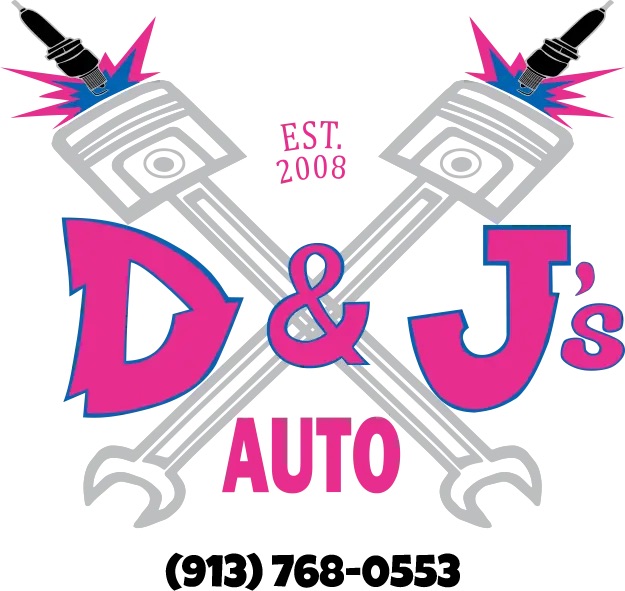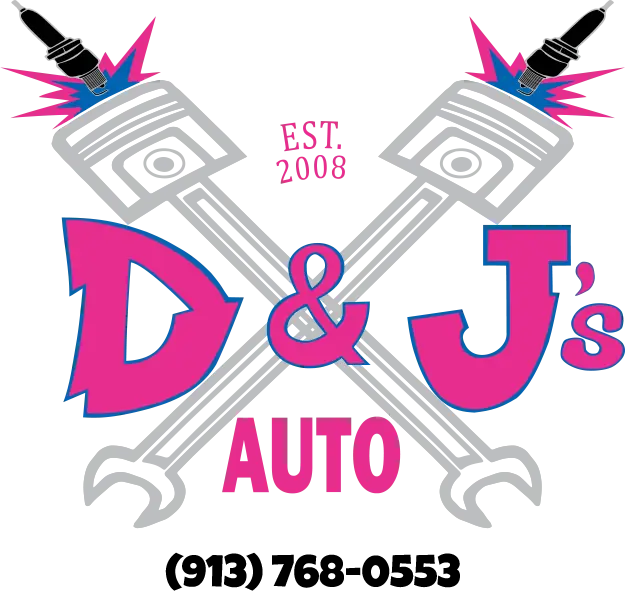Our Monthly Blog

The Most Common Car Noises & What They Might Mean
At D & J’s Automotive in Olathe, KS, one of the most frequent things we hear from drivers is: “My car is making a weird noise.” It might be a squeak, grind, rattle or thump — and while these noises may seem minor, they often point to something needing attention. In this post, we’ll walk through the most common car noises, what they could mean, and why it’s best to have them checked sooner rather than later.
1. Squealing or Screeching When You Start or Accelerate
What it might be:
-
A worn or loose serpentine belt (drive belt).
-
A failing belt tensioner or idler pulley.
-
Worn accessory components (such as an alternator or AC compressor) pulling more load on the belt.
-
Brake pads may be worn and causing a high‑pitched squeal when moving.
Why you should care:
A failing belt can snap, leaving you stranded (no power steering, no charging system). If the noise is from brakes, it may indicate the pads are so thin the wear indicator is touching the rotor.What you can do:
-
Note when you hear the noise: at start, when accelerating, when turning, only when cold/hot?
-
Listen for any “slipping” smell (belt slipping often smells like rubber).
-
Bring your car into us at D & J’s Automotive so we can inspect belts, pulleys and brake condition.
2. Grinding or Growling When You Apply the Brakes
What it might be:
-
Metal‑on‑metal contact because the brake pads are worn out.
-
Warped brake rotors.
-
A stuck caliper or foreign object caught in the brake system.
-
Wheel bearing issues (sometimes a similar sound when cornering).
Why you should care:
Brakes are critical for your safety. What might sound like a small annoyance could be accelerating rotor damage or failing brakes.What you can do:
-
Pay attention to whether it happens when you brake lightly vs. hard.
-
Note whether the noise is coming from front wheels, rear wheels, or only when turning.
-
Schedule an inspection at our Olathe shop so we can measure pad thickness, inspect rotors and check wheel bearings.
3. Rattling or Clinking When You’re Driving or Over Bumps
What it might be:
-
Loose exhaust components (heat shields, hangers).
-
Loose or damaged suspension parts (control arms, sway‑bar links, bushings).
-
Loose under‑body panels or splash shields.
-
A failing CV joint or driveshaft component.
Why you should care:
What sounds like a harmless rattle could turn into a serious suspension failure or cause damage to other components if left unchecked.What you can do:
-
Note whether the noise happens only going over bumps, when turning, or when accelerating.
-
Try to identify whether it seems from front, middle, or rear of the vehicle.
-
Bring the vehicle in for a thorough under‑car inspection — we’ll lift it, check the exhaust hangers, suspension links, and driveshaft joints.
4. Knocking or Pinging from the Engine
What it might be:
-
Engine knock (pre‑ignition or detonation) due to low octane fuel, carbon build‑up, or timing issues.
-
Connecting rod bearing knock (especially at higher mileage).
-
A failing engine mount causing the engine to shift and knock into other components.
-
Fuel injector or ignition issues causing mis‑fires.
Why you should care:
Engine knocking is a serious warning sign — it may indicate internal damage, and delaying repair can make it worse (and more expensive).What you can do:
-
Note whether it happens under load (accelerating, climbing hills), when cold or hot, at idle or high RPM.
-
Avoid heavy loads or hard driving until inspected.
-
Visit our ASE‑certified techs at D & J’s Automotive — we’ll run diagnostics, inspect engine mounts, listen for bearing noise, and evaluate fuel/ignition system.
5. Squeaking or Chirping from the Suspension or Steering When Turning
What it might be:
-
Worn steering or suspension bushings.
-
Dry ball joints or tie‑rod ends.
-
Low power steering fluid or a failing power steering pump.
-
Strut mount bearing worn out causing the strut to squeak as you turn.
Why you should care:
Issues in the steering or suspension not only cause annoying noise — they can affect handling and safety (reduced control, poor alignment, uneven tire wear).What you can do:
-
Listen when turning the wheel slowly both ways.
-
Check whether the noise happens only when cold or continues once warm.
-
Bring the vehicle in so we can inspect bushings, joints, power steering system and make alignment or suspension repairs as needed.
6. Hissing or Whistling Under the Hood or When Accelerating
What it might be:
-
A vacuum leak in the intake manifold or vacuum lines.
-
A failing or leaking turbocharger (if equipped).
-
A cracked hose or hose clamp loose in the cooling or intake system.
-
Leaking gasket (intake manifold or throttle body gasket) causing air leakage.
Why you should care:
A vacuum or intake leak may seem minor but can cause poor engine performance, higher fuel consumption, check engine light, and long‑term engine wear.What you can do:
-
Notice when you hear it: only at idle, only on acceleration, only hot/cold?
-
Check whether engine feel is rough or sluggish.
-
Bring it to us — we’ll use smoke testing or inspection to pinpoint leaks and restore proper engine function.
Why Early Diagnosis Matters
At D & J’s Automotive, our goal is not just to fix your car — it’s to keep you safe and prevent small issues from turning into major repairs. Many of the noises above, if caught early, can be addressed at moderate cost. But if you wait, you risk:
-
Increased repair costs
-
Reduced vehicle reliability
-
Compromised safety
-
Potential for being stranded
What to Do When You Hear Something Unusual
-
Don’t ignore it. The longer you wait, the higher the chance of further damage.
-
Record the circumstances. Note when the noise happens, what you were doing, where it seems to come from. The more info our technicians have, the faster we can locate the issue.
-
Schedule an inspection. At our Olathe shop, we’ll listen, lift the vehicle, and perform the proper diagnostics.
-
Follow the repair recommendations. We’ll provide you clear options — you stay in control of what’s done and when.
-
Maintain your vehicle. Routine service is key to preventing many of these noises before they start.
Why Choose D & J’s Automotive
-
Our technicians are ASE‑certified and undergo ongoing training, giving you dealership‑level expertise without the dealer pricing.
-
We’ve been serving the Olathe community since 2008, building a reputation for reliable, friendly service.
-
We’re a full‑service repair center — from brakes to engines to diagnostics, we’ve got you covered.
-
We believe in transparent communication: you’ll know what the noise means, what needs fixing, and how much it will cost.
Get Your Car Checked Today
If your vehicle is talking to you (OK, maybe shouting), don’t ignore it. Bring it to D & J’s Automotive at 375 N Ridgeview Rd., Olathe, KS 66061, or give us a call at 913‑768‑0553 to book your appointment. Let our skilled team help you get back on the road confidently — and quietly.
11/05/2025Read more-

Winterizing Your Vehicle: Essential Tips from D & J's Automotive
As the crisp air of fall settles in, it's time to prepare your vehicle for the challenges of winter driving. At D & J's Automotive, we understand the importance of keeping your car in top condition during the colder months. Here's a comprehensive guide to ensure your vehicle is winter-ready.
❄️ 1. Battery Health
Cold temperatures can strain your car's battery. It's crucial to have your battery tested to ensure it holds a full charge. Corroded or loose connections can impede performance, so clean and secure terminals as needed. If your battery is over three years old, consider replacing it before the first freeze.
🛞 2. Tire Maintenance
Proper tire maintenance is vital for winter driving. Check tire pressure regularly, as it can drop with colder temperatures. Ensure the tread depth is adequate for traction on icy roads. If you frequently drive in snowy conditions, consider switching to snow tires for enhanced grip.
🧊 3. Windshield Wipers & Fluid
Visibility is paramount in winter. Replace worn wiper blades and fill your reservoir with freeze-resistant washer fluid. Consider using winter-grade fluid with de-icer to prevent buildup. Keep your windshield clean and clear to ensure optimal visibility.
🔧 4. Fluids & Coolant
Check all essential fluids, including engine oil, brake fluid, and transmission fluid. Switch to synthetic oil if you haven't already, as it performs better in low temperatures. Ensure your coolant is at the proper level and mix ratio to prevent freezing.
🔦 5. Lights & Defrosters
Shorter days mean more driving in the dark. Test all headlights, taillights, and turn signals to ensure they're functioning correctly. Verify that your heater and defroster are working efficiently to maintain comfort and visibility.
🚨 6. Emergency Kit Essentials
Prepare for unexpected situations by keeping an emergency kit in your vehicle. Include items like a flashlight, jumper cables, ice scraper, blanket, non-perishable snacks, and a first aid kit. These supplies can be invaluable if you become stranded.
🧰 7. Professional Inspection
While some maintenance tasks can be handled at home, a professional inspection ensures all systems are functioning optimally. At D & J's Automotive, our experienced technicians can perform a thorough winter check-up to identify and address potential issues before they become problems.
Schedule Your Winter Maintenance Today
Don't wait until the first snowstorm to address these essential tasks. Contact D & J's Automotive at 913-768-0553 or schedule an appointment online. Let us help you stay safe and confident on the road this winter.
By following these steps, you can ensure your vehicle is prepared for the challenges of winter driving. Regular maintenance not only extends the life of your car but also provides peace of mind during the colder months.
10/06/2025Read more
Make an Appointment
Let us know how we can help you. Schedule your appointment online.